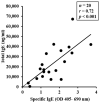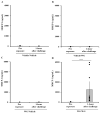Is Wheat Glutenin Extract Intrinsically Allergenic? Evaluation Using a Novel Adjuvant-Free Mouse Model of Systemic Anaphylaxis
- PMID: 38139075
- PMCID: PMC10743909
- DOI: 10.3390/ijms242417247
Is Wheat Glutenin Extract Intrinsically Allergenic? Evaluation Using a Novel Adjuvant-Free Mouse Model of Systemic Anaphylaxis
Abstract
Wheat is a prominent allergenic food that can trigger life-threatening anaphylaxis. Presently, it remains unclear whether wheat glutenin (WG) extract possesses inherent sensitization potential independently, without the use of adjuvants, and whether it can sensitize mice to the extent of inducing life-threatening systemic anaphylaxis. In this study, we tested the hypothesis that repeated skin exposures to WG extract without adjuvant will sensitize mice with the resultant anaphylactic reaction upon systemic WG challenge. Balb/c mice were bred and maintained on a strict plant protein-free diet and were repeatedly exposed to a WG extract or vehicle once a week for 9 weeks. WG-specific (s)IgE and total (t)IgE levels were quantified. Mice were challenged with WG extract to induce anaphylactic reactions as measured by hypothermic shock response (HSR) and mucosal mast cell degranulation response (MMCR). We also conducted proteomic analysis of 120 spleen immune markers. These skin-sensitized mice exhibited exposure-dependent IgE responses and near-fatal anaphylaxis upon challenge. Proteomic analysis identified seven dramatically elevated immune biomarkers in anaphylactic mice. These data reveal that WG is intrinsically allergenic, and that chronic skin exposure to WG extract can prime the mice for potentially fatal anaphylaxis.
Keywords: IgE; glutenin allergy; mouse model; skin sensitization; systemic anaphylaxis.
Conflict of interest statement
The authors declare no conflict of interest.
Figures








Similar articles
-
Glutenin from the Ancient Wheat Progenitor Is Intrinsically Allergenic as It Can Clinically Sensitize Mice for Systemic Anaphylaxis by Activating Th2 Immune Pathway.Int J Mol Sci. 2024 Jul 3;25(13):7324. doi: 10.3390/ijms25137324. Int J Mol Sci. 2024. PMID: 39000431 Free PMC article.
-
Chronic application of alcohol-soluble gluten extract over undamaged skin causes clinical sensitization for life-threatening anaphylaxis via activation of systemic Th2 immune responses in mice.Front Allergy. 2023 Sep 29;4:1214051. doi: 10.3389/falgy.2023.1214051. eCollection 2023. Front Allergy. 2023. PMID: 37841051 Free PMC article.
-
An Adjuvant-Free Mouse Model Using Skin Sensitization Without Tape-Stripping Followed by Oral Elicitation of Anaphylaxis: A Novel Pre-Clinical Tool for Testing Intrinsic Wheat Allergenicity.Front Allergy. 2022 Jun 24;3:926576. doi: 10.3389/falgy.2022.926576. eCollection 2022. Front Allergy. 2022. PMID: 36238931 Free PMC article.
-
Wheat-dependent exercise-induced anaphylaxis.Clin Exp Allergy. 2016 Jan;46(1):10-20. doi: 10.1111/cea.12640. Clin Exp Allergy. 2016. PMID: 26381478 Review.
-
Role of IgE in the development of allergic airway inflammation and airway hyperresponsiveness--a murine model.Allergy. 1999 Apr;54(4):297-305. doi: 10.1034/j.1398-9995.1999.00085.x. Allergy. 1999. PMID: 10371087 Review.
Cited by
-
Advances in Mechanisms of Anaphylaxis in Wheat Allergy: Utility of Rodent Models.Foods. 2025 Mar 5;14(5):883. doi: 10.3390/foods14050883. Foods. 2025. PMID: 40077585 Free PMC article. Review.
-
Advances in Gluten Hypersensitivity: Novel Dietary-Based Therapeutics in Research and Development.Int J Mol Sci. 2024 Apr 16;25(8):4399. doi: 10.3390/ijms25084399. Int J Mol Sci. 2024. PMID: 38673984 Free PMC article. Review.
-
Glutenin from the Ancient Wheat Progenitor Is Intrinsically Allergenic as It Can Clinically Sensitize Mice for Systemic Anaphylaxis by Activating Th2 Immune Pathway.Int J Mol Sci. 2024 Jul 3;25(13):7324. doi: 10.3390/ijms25137324. Int J Mol Sci. 2024. PMID: 39000431 Free PMC article.
References
-
- Venter C., Pereira B., Grundy J., Clayton C.B., Arshad S.H., Dean T. Prevalence of Sensitization Reported and Objectively Assessed Food Hypersensitivity amongst Six-Year-Old Children: A Population-Based Study. Pediatr. Allergy Immunol. 2006;17:356–363. doi: 10.1111/j.1399-3038.2006.00428.x. - DOI - PubMed
MeSH terms
Substances
Grants and funding
- The United States Department of Agriculture (USDA)/National Institute of Food and Agriculture (NIFA); Hatch project MICL02486 (Accession Number: 1012322), MICL02796, Hatch project MICL01699; Agricultural and Food Research Initiative Competitive Program, g/United States Department of Agriculture
- NIFA: MICL05103/United States Department of Agriculture
LinkOut - more resources
Full Text Sources
Medical

